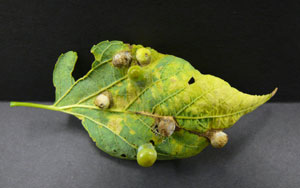Indiana has a new nuisance called the 'oak leaf gall mite'
Ag Communications
By Julie Douglas
October 4, 2007
 |
| A leaf from a hackberry tree is covered with galls, home to the insect and mite. The oak gall mite is a nuisance in Nebraska, Kansas and Colorado and has recently been found in trees around Chicago. The external parasite's primary host is insects that are parasitic on oak trees. (Purdue University photo/Julie Douglas) |
WEST LAFAYETTE, Ind. -
Indiana trees are now suspected to be home to the oak gall mite, a parasite on a parasite.
The oak gall mite, formally known as Pyemotes herfsi, is a nuisance in Nebraska, Kansas and Colorado and has recently been found in trees around Chicago, said a Purdue University expert.
The external parasite's primary host is insects that are parasitic on oak trees. These parasitic insects feed on a tree's leaves, causing a deformity of the leaf called a gall that looks like a pustule. The insects live in the gall, which is where the problem lies, said Tim Gibb, a Purdue Extension entomologist.
Insecticides can't be used to treat the mites because they do not penetrate the gall, the home of the insect and mite, Gibb said.
"Unlike the name might suggest, the oak gall mite is not just found on insects in oak trees," Gibb said. "We know for sure they are on oak trees, but because many of those insects also make galls on other trees there is reason to believe they are on other trees as well."
When there are not enough insects acting as hosts for the mites, humans and animals become secondary hosts, he said.
"Don't panic yet. These mites do not carry diseases and are very similar to chiggers," Gibb said. "They are strictly a nuisance and there is no need to stop outdoor activities."
The oak gall mite is tiny and hardly visible to the naked eye, Gibb said. The mite measures in at approximately 100th of an inch or equivalent to the size of the point of a needle or the width of three human hairs.
Gibb said mites can be dispersed in the air, but a person is at higher risk if working in trees or in direct contact with leaves that have galls.
"Most people can't see the mite, but can feel it moving," Gibb said. "When they get on people, they typically go to pores or hair follicles.
"Once they pick a spot they inject their saliva, which desensitizes the skin around it and then suck lymph from the body. The person won't know until four- or five-plus hours later when the skin becomes sensitive and develops a rash or welt that itches."
He added that peoples' immune systems respond differently to being bitten just like the different reactions people have to a mosquito sting, chigger bite or bee sting. These soft-bodied mites die easily and drop off after feeding.
Outdoor enthusiasts can take simple measures like wearing pants, long sleeve shirts, a hat and insect repellant to prevent being bitten by the mite, Gibb said.
"If coming from an area heavily populated by oak trees or areas where mites may have been, showering with lots of soap will kill or wash off the mites," Gibb said. "It's also important to remove and wash clothing items because the mites can remain in the fabric for several days."
Writer: Julie Douglas, (765) 496-1050, douglajk@purdue.edu
Source: Tim Gibb, (765) 494-4570, gibb@purdue.edu
Ag Communications: (765) 494-2722;
Beth Forbes, forbes@purdue.edu
Agriculture News Page
|